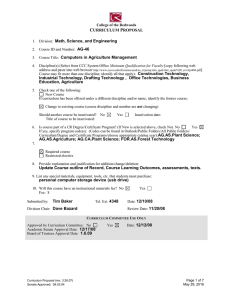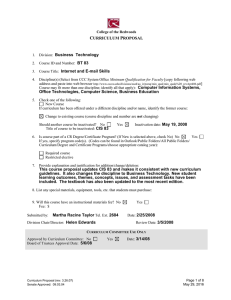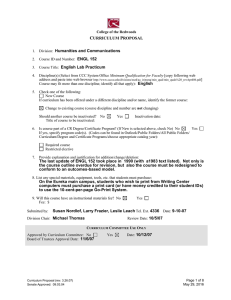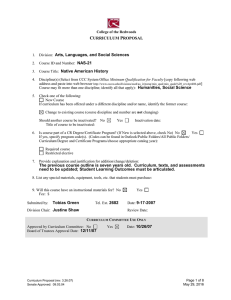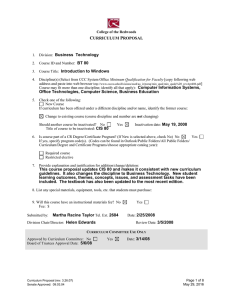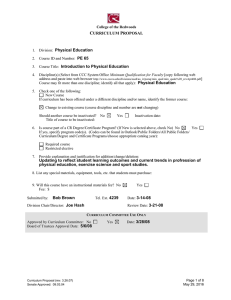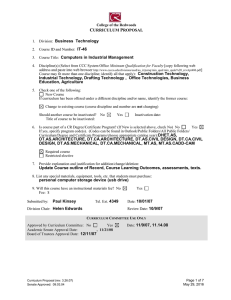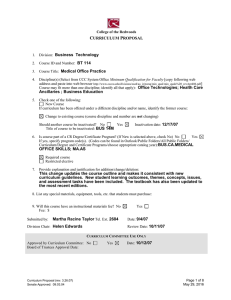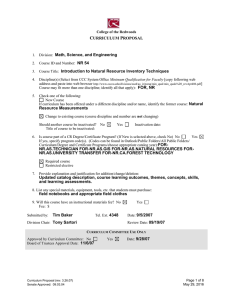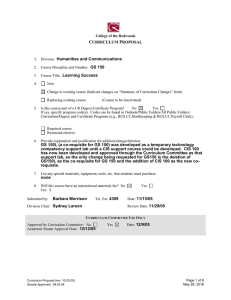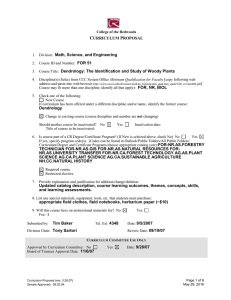C P URRICULUM
advertisement
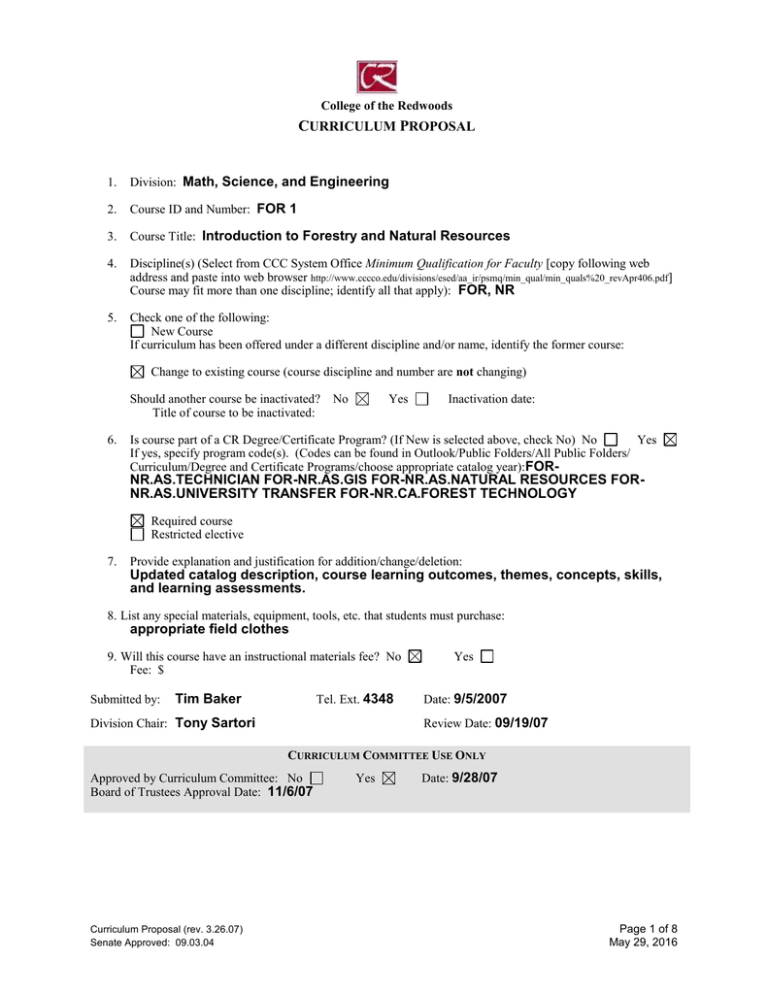
College of the Redwoods CURRICULUM PROPOSAL 1. Division: Math, Science, and Engineering 2. Course ID and Number: FOR 1 3. Course Title: Introduction to Forestry and Natural Resources 4. Discipline(s) (Select from CCC System Office Minimum Qualification for Faculty [copy following web address and paste into web browser http://www.cccco.edu/divisions/esed/aa_ir/psmq/min_qual/min_quals%20_revApr406.pdf] Course may fit more than one discipline; identify all that apply): FOR, NR 5. Check one of the following: New Course If curriculum has been offered under a different discipline and/or name, identify the former course: Change to existing course (course discipline and number are not changing) Should another course be inactivated? Title of course to be inactivated: 6. No Yes Inactivation date: Is course part of a CR Degree/Certificate Program? (If New is selected above, check No) No Yes If yes, specify program code(s). (Codes can be found in Outlook/Public Folders/All Public Folders/ Curriculum/Degree and Certificate Programs/choose appropriate catalog year):FOR- NR.AS.TECHNICIAN FOR-NR.AS.GIS FOR-NR.AS.NATURAL RESOURCES FORNR.AS.UNIVERSITY TRANSFER FOR-NR.CA.FOREST TECHNOLOGY Required course Restricted elective 7. Provide explanation and justification for addition/change/deletion: Updated catalog description, course learning outcomes, themes, concepts, skills, and learning assessments. 8. List any special materials, equipment, tools, etc. that students must purchase: appropriate field clothes 9. Will this course have an instructional materials fee? No Fee: $ Submitted by: Tim Baker Tel. Ext. 4348 Division Chair: Tony Sartori Yes Date: 9/5/2007 Review Date: 09/19/07 CURRICULUM COMMITTEE USE ONLY Approved by Curriculum Committee: No Board of Trustees Approval Date: 11/6/07 Curriculum Proposal (rev. 3.26.07) Senate Approved: 09.03.04 Yes Date: 9/28/07 Page 1 of 8 May 29, 2016 SUMMARY OF CURRICULUM CHANGES FOR AN EXISTING COURSE FEATURES Catalog Description (Please include complete text of old and new catalog descriptions.) Grading Standard OLD NEW An introduction to the forestry and natural resource management professions. The history of forestry and natural resource management in the US will be studied, as well as the current policies and issues affecting the management of our resources. Basic concepts and practices involving forest ecology and growth, measurements, wildlife, recreation, and watershed management will be covered as well as forestry and natural resource management career possibilities. An introduction to forest and natural resource issues and management. The lectures and discussion cover 3 general areas: goods and services derived from forests; basic management strategies for natural resources; and the development and application of relevant policies and regulations, including historical perspectives. Weekly field exercises introduce students to basic techniques for field work and how different management approaches are applied in the woods. Select Select Total Units Lecture Units Lab Units Prerequisites Corequisites Recommended Preparation Maximum Class Size 25 Repeatability— Maximum Enrollments Other Course learning outcomes, course content, learning assessments If any of the listed features have been modified in the new proposal, indicate the “old” (current) information and proposed changes. Curriculum Proposal (rev. 3.26.07) Senate Approved: 09.03.04 Page 2 of 8 May 29, 2016 College of the Redwoods COURSE OUTLINE DATE: 9/5/2007 COURSE ID AND NUMBER: FOR 1 COURSE TITLE: Introduction to Forestry and Natural Resources FIRST TERM NEW OR REVISED COURSE MAY BE OFFERED: Spring 2008 TOTAL UNITS: 3 TOTAL HOURS: 90 [Lecture Units: 2 [Lecture Hours: 36 Lab Units: 1] Lab Hours: 54] MAXIMUM CLASS SIZE: 25 GRADING STANDARD Letter Grade Only CR/NC Only Is this course repeatable for additional credit units: No Grade-CR/NC Option Yes If yes, how many total enrollments? Is this course to be offered as part of the Honors Program? No Yes If yes, explain how honors sections of the course are different from standard sections. CATALOG DESCRIPTION The catalog description should clearly state the scope of the course, its level, and what kinds of student goals the course is designed to fulfill. An introduction to forest and natural resource issues and management. The lectures and discussion cover three general areas: goods and services derived from forests; basic management strategies for natural resources; and the development and application of relevant policies and regulations, including historical perspectives. Weekly field exercises introduce students to basic techniques for field work and how different management approaches are applied in the woods. Special notes or advisories: Field trips are required; the College does not provide transportation. PREREQUISITES No Yes Course(s): Rationale for Prerequisite: Describe representative skills without which the student would be highly unlikely to succeed . COREQUISITES No Yes Rationale for Corequisite: Curriculum Proposal (rev. 3.26.07) Senate Approved: 09.03.04 Course(s): Page 3 of 8 May 29, 2016 RECOMMENDED PREPARATION No Yes Course(s): Rationale for Recommended Preparation: COURSE LEARNING OUTCOMES What should the student be able to do as a result of taking this course? State some of the objectives in terms of specific, measurable student accomplishments. 1.Explain the range and relative importance of goods and services derived from natural resources. 2. Explain natural resource management strategies within historical context 3. Explain the basic socio-economic forces shaping forest policies. 4. Define and use natural resource management terms and technical language 5. Derive and explain the implications of various management techniques on amenity benefits, goods and services. COURSE CONTENT Themes: What themes, if any, are threaded throughout the learning experiences in this course? Balancing social demands with ecological limitations in managing natural resources. Concepts: What concepts do students need to understand to demonstrate course outcomes? 1. Historical framework of changing natural resource policies. 2. Complexities surrounding natural resource management problems. 3. Social and economic forces shaping laws and regulations on forests and natural resources. Issues: What primary issues or problems, if any, must students understand to achieve course outcomes (including such issues as gender, diversity, multi-culturalism, and class)? The complexity of conflicting societal demands on forest ecosystems. Skills: What skills must students master to demonstrate course outcomes? 1. Basic field navigation techniques with maps, compass and pacing. 2. Basic tree measurement techniques and data analysis. 3. Preliminary evaluation of impacts of forest users. 4. Critical evaluation of forest policy and diverse viewpoints. REPRESENTATIVE LEARNING ACTIVITIES What will students be doing (e.g., listening to lectures, participating in discussions and/or group activities, attending a field trip)? Relate the activities directly to the Course Learning Outcomes. 1. Listening to lectures and participating in class discussions on the demands for goods and services from forests and the historical development of current policies. 2. Reading and evaluating assigned papers on current issues in natural resource management. 3. Participating in field exercises and field trips to various ecosystems to evaluate and discuss implications of management. 4. Participating in small group projects on controversial natural resource issues important locally. Curriculum Proposal (rev. 3.26.07) Senate Approved: 09.03.04 Page 4 of 8 May 29, 2016 ASSESSMENT TASKS How will students show evidence of achieving the Course Learning Outcomes? Indicate which assessments (if any) are required for all sections. Representative assessment tasks: 1. Exams that ask students to define technical terms, 2. Answer questions about goods and services, history, management approaches 3. Evaluate applications. 2. Write lab reports that summarize and analyze various field exercises and field evaluations. Required assessments for all sections – to include but not limited to: Comprehensive final exam. EXAMPLES OF APPROPRIATE TEXTS OR OTHER READINGS Author, Title, and Date Fields are required Author Sharpe et al. Author Burton Title Title Introduction to Forests and Renewable Resources Introduction to Forest Science Author Title Date Author Title Date Date Date 2003 2000 Other Appropriate Readings: Selected articles from Journal of Forestry; Western Journal of Applied Forestry; Frontiers in Ecology. Curriculum Proposal (rev. 3.26.07) Senate Approved: 09.03.04 Page 5 of 8 May 29, 2016 PROPOSED TRANSFERABILITY: CSU UC If CSU transferability is proposed (courses numbered 1-99), indicate whether general elective credit or specific course equivalent credit is proposed. If specific course equivalent credit is proposed, give course numbers/ titles of at least two comparable lower division courses from a UC, CSU, or equivalent institution. None General elective credit Specific course equivalent 1. FOR 116, Humboldt State University (Campus) 2. FNR 201, Cal Poly- San Luis Obispo (Campus) CURRENTLY APPROVED GENERAL EDUCATION CR CSU IGETC CR GE Category: CSU GE Category: IGETC Category: PROPOSED CR GENERAL EDUCATION Rationale for CR General Education approval (including category designation): Natural Science Social Science Humanities Language and Rationality Writing Oral Communications Analytical Thinking PROPOSED CSU GENERAL EDUCATION BREADTH (CSU GE) A. Communications and Critical Thinking A1 – Oral Communication A2 – Written Communication A3 – Critical Thinking C. Arts, Literature, Philosophy, and Foreign Language C1 – Arts (Art, Dance, Music, Theater) C2 – Humanities (Literature, Philosophy, Foreign Language) E. Lifelong Understanding and SelfDevelopment E1 – Lifelong Understanding E2 – Self-Development B. Science and Math B1 – Physical Science B2 – Life Science B3 – Laboratory Activity B4 – Mathematics/Quantitative Reasoning D. Social, Political, and Economic Institutions D0 – Sociology and Criminology D1 – Anthropology and Archeology D2 – Economics D3 – Ethnic Studies D5 – Geography D6 – History D7 – Interdisciplinary Social or Behavioral Science D8 – Political Science, Government and Legal Institutions D9 – Psychology Rationale for inclusion in this General Education category: Same as above Curriculum Proposal (rev. 3.26.07) Senate Approved: 09.03.04 Page 6 of 8 May 29, 2016 Proposed Intersegmental General Education Transfer Curriculum (IGETC) 1A – English Composition 1B – Critical Thinking-English Composition 1C – Oral Communication (CSU requirement only) 2A – Math 3A – Arts 3B – Humanities 4A – Anthropology and Archaeology 4B – Economics 4E – Geography 4F – History 4G – Interdisciplinary, Social & Behavioral Sciences 4H – Political Science, Government & Legal Institutions 4I – Psychology 4J – Sociology & Criminology 5A – Physical Science 5B – Biological Science 6A – Languages Other Than English Rationale for inclusion in this General Education category: Curriculum Proposal (rev. 3.26.07) Senate Approved: 09.03.04 Same as above Page 7 of 8 May 29, 2016 FOR VPAA USE ONLY PROGRAM AND COURSE NUMBER FOR-1 TECHNICAL INFORMATION 1. Department: SCI Science 16. CoRequisite Course: None 2. Subject: Forestry 17. Recommended Prep: None Course No: 1 3. Credit Type: D Credit Degree Applicable 18. Maximum Class Size: 25 4. Min/Maximum Units: 3.0 to 19. Repeat/Retake: NR No repeats variable units 5. Course Level: D Possibly Occupational 20. Count Retakes for Credit: yes no 6. Academic Level: UG Undergraduate 21. Only Pass/No Pass: yes no 7. Grade Scheme: UG Undergraduate 22. Allow Pass/No Pass: yes no 8. Short Title: Intro to Forestry/Natural Res 23. VATEA Funded Course: yes no 9. Long Title: Introduciton to Froestry and 24. Accounting Method: Choose One: Natural Res 25. Disability Status: N Not a Special Class 10. National ID (CIP): 03.0501 26. Billing Method: T-Term 11. Local ID (TOPS): 011400 27. Billing Period: R-Reporting Term 12. Course Types: Level One Basic Skills: NBS Not Basic Skills Level Two Work Experience: 28. Billing Credits: 3.0 29. Purpose: I Occupational Ed NWE Not Coop Work Experience 30. Articulation No. Level Three: (CAN): Placeholder for GE OR 31. Articulation Seq. (CAN): DOES NOT APPLY 32. Transfer Status: A Transfers to both UC/CSU Level Four: If GE : Choose One: 33. Equates to another course? (course number). 13. Instructional Method: LL Lecture/Lab 14. Lec TLUs: 3.0 Contact Hours: 36 Lab TLUs: 3.0 Contact Hours: 54 Lecture/Lab TLUs: 6.0 Contact Hours: 90 34. The addition of this course will inactive number). Inactive at end of term. 15. Prerequisite: None Particular Comments for Printed Catalog. . Curriculum Approval Date: 9/28/07 Curriculum Proposal (rev. 3.26.07) Senate Approved: 09.03.04 Page 8 of 8 May 29, 2016 (course
